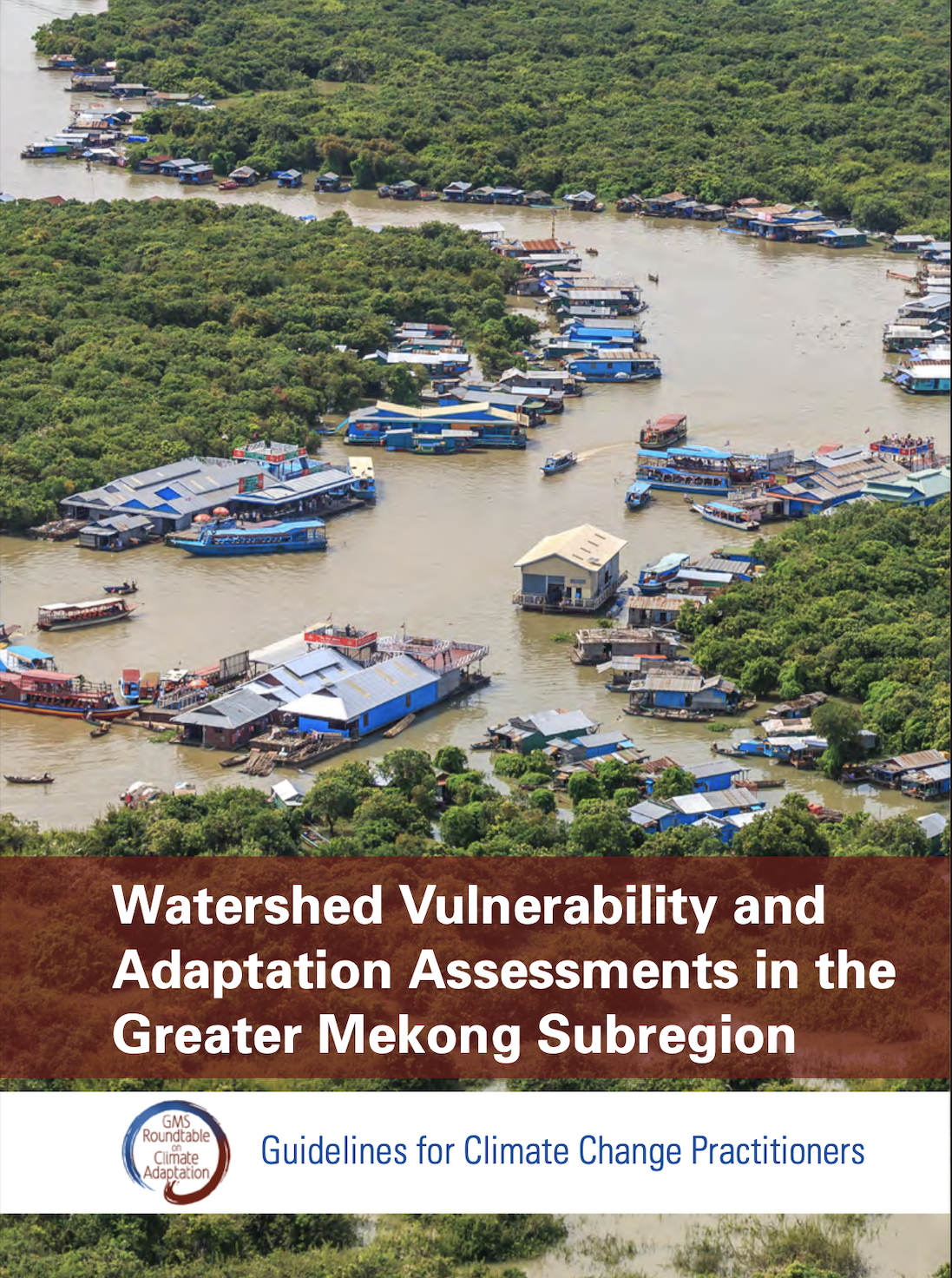Watershed Vulnerability and Adaptation Assessments in the Greater Mekong Subregion

Introduction
A number of organizations in the Greater Mekong Subregion (GMS) work closely with the six member countries of the GMS to help them more effectively integrate climate-change considerations into development-related decisions.Such support covers numerous areas, including policy analysis, technical research, tools and approaches, and the piloting of field-based interventions. In early 2013, the GMS Core Environment Program initiated the GMS Climate Adaptation Roundtable as a platform for bringing together researchers and practitioners from various regional organizations to exchange knowledge and best practices, identify gaps, and work together to plug those gaps.
The Bangkok-based roundtable partners are:
-
(ii) The International Union for Conservation of Nature (IUCN)
-
(iii) Mekong Region Futures Institute (MERFI)
-
(iv) United States Agency for International Development Mekong Adaptation and Resilience to Climate Change (USAID Mekong ARCC) project
-
(v) United States Forest Service (USFS)
-
(vi) Stockholm Environment Institute (SEI) and Sustainable Mekong Research Network (SUMERNET)
-
(vii) Thailand Environment Institute (TEI)
-
(viii) Southeast Asia START Regional Center (SEA START RC)
-
(ix) Food and Agriculture Organization (FAO) Regional Office for Asia and the Pacific
These regional guidelines on watershed-scale vulnerability and adaptation assessments (W-VAAs) are the product of a multiyear collaboration among the institutions listed above. The guidelines synthesize the shared knowledge and experience of the roundtable partners in developing frameworks for vulnerability and adaptation assessments (VAAs) and implementing them in the GMS over the past decade. Specifically, these guidelines incorporate the direct experience of recent projects that have used watersheds as an organizing element for climate-change VAAs.
Summary
The Mekong River Basin is known for its physical, biological, and cultural diversity. In fact, it routinely garners international headlines because of the new species discovered there every year. But for each one of these reports, there are countless more stories about uncertainty, not just regarding the basin’s ecology, but also the societies of this six-nation region, as their exposure to the effects of climate change is predicted to be among the most extensive in the world.
What is not being reported, however, is the fact that a new form of diversity is rapidly evolving in response to this uncertainty. It is both bottom-up and top-down. It involves village elders paired off with industry executives, and old-school sandals-on-the-ground surveys combined with supercomputer models. It is an interdisciplinary, inter-sector, and intensively interactive planning movement led by a diverse set of stakeholders who are pioneering various approaches and tools with one goal in mind: to strengthen the region’s capacity to reduce climate change risk by creatively applying watershed-scale vulnerability and adaptation assessments (W-VAAs).
Authored by the Greater Mekong Subregion (GMS) Climate Change Adaptation Roundtable, this document represents a natural iteration of these efforts. The guidelines herein represent a coalescence of the knowledge and experience of its members, distilled in such a way as to facilitate W-VAA uptake in the Mekong region and beyond. The aim is to provide a consistent, yet flexible approach to W-VAAs that practitioners from the governments, international and local organizations, and communities can utilize to improve the effectiveness of their climate-change adaptation planning.
Methods and Tools
The tools and approaches discussed in the guidelines are arranged in four chapters.
Chapter 1 introduces the W-VAA by first charting its evolution from the limitations of earlier vulnerability- and-adaptation assessment (VAA) frameworks, and then identifies how W-VAAs fill critical gaps in those frameworks. The chapter next outlines why using a watershed perspective is critical, stressing that, as watersheds are nature’s units of ecological and landscape organization that have historically guided human settlements and economic activities, they are ideal units of analysis for understanding the interplay of socioeconomic and ecological factors in the face of climate change. The chapter concludes by discussing the types of practitioners and stakeholders who should consider incorporating a W-VAA into their climate- change planning.
Chapter 2 lays out seven principles that the Roundtable has concluded are critical for guiding the formulation, implementation, and evaluation of an effective W-VAA process. These are: focus on informing decision-making; stay within a well-defined scope; consider the complexities of socio-ecological systems; take future risks and uncertainties into account; ensure a participatory approach; increase the social capacity to reorganize in the face of risks; and monitor, evaluate, and learn.
Chapter 3 outlines five main steps in conducting a W-VAA. These are: scope the assessment context, particularly the decision or policy it is intended to influence; conduct a baseline vulnerability assessment; identify, evaluate, and prioritize adaptation options; integrate adaptation options into action plans and watershed-management plans; and synthesize learning and improve the W-VAA process. The remainder of the chapter provides seven replicable examples of how W-VAAs are being implemented in the Mekong region, with each example illustrating specific W-VAA principles and steps in the W-VAA process.
Chapter 4 presents a wide range of qualitative and quantitative tools that W-VAA practitioners can employ when conducting their assessments. While the principle output of these tools is the gathering and evaluation of information on climate change, vulnerabilities, and adaptation options, many of the tools also help to reinforce public participation; consensus building; and local leadership, which is especially important in driving the process and its outcomes.
Recommended Citation:
Smajgl, A., Salamanca, A., Steel, A., Blate, G., Long, J., Hartman, P., Manuamorn, O., Sawhney, P., Friend, R., Gustafson, S. & Chinvanno, S. (2017) Guidelines for Climate Change Adaptation Practitioners for Greater Mekong Subregion. Greater Mekong Subregion Core Environment Program and US Forest Service, Bangkok.
(0) Comments
There is no content